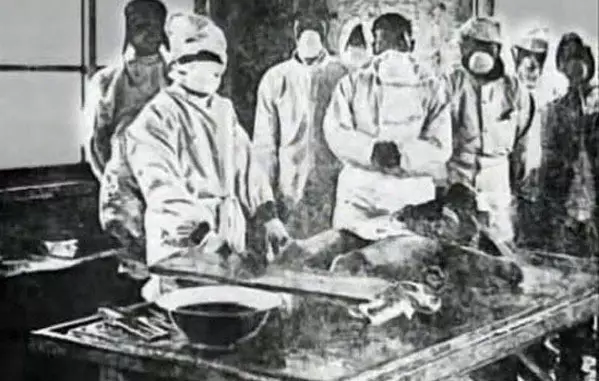
I recently stood in the heart of Auschwitz Birkenau (II), looking out from the watch tower, above the main train tracks, which marks the main entrance into the camp. As far as the eye could see there were ruins where an estimated one and a half million people stood before they were either murdered outright or worked to death.
It's hard to imagine a place more horrific than a place that, in my opinion, is built upon nightmares. But it turns out the German army wasn't the only one committing atrocities. There is a place that's equally as terrifying that operated in a similar way. Japan called it 'Unit 731'.
Most of us have heard of the horrendous experiments that Nazi doctor Josef Mengele performed on humans during the holocaust. His methods were excruciatingly painful, wrong and cruel to say the least. Meanwhile, during the same time this was happening in Germany, are you aware that similar experiments were taking place in China? Neither were a lot of people, apparently.
For 40 years, unimaginable torture happened in a complex in Pingfang, China, called 'Unit 731'. The incidents that occurred there remained one of the most closely guarded secrets of World War II for years after it was demolished.
Only in recent history, in 1984, has Japan finally acknowledged what it had long-denied - the repugnant experiments on humans conducted by the unit in preparation for germ warfare. Basically, its involvement in the murders of thousands of people to find innovative ways to murder yet more innocent people.
Although the camp was based in China, it was operated in - and the blame very much lies with - Japanese nationalists.
The nation's push into China commenced in 1931. Unit 731 began conducting germ warfare experiments from its headquarters in Harbin, north-east China, in the mid 1930s.
The site rivalled the notorious Auschwitz-Burkenau death camp in size. Like the largest concentration camp that operated in Europe, Unit 731's location was chosen, too, for its secrecy and security.
Inmates were deliberately infected with plague, anthrax, cholera and other pathogens. Its guinea pigs were enemies of the state - soldiers as well as civilians - men, women and even children.
Advert

Image credit: YouTube/Alltime Conspiracies
It is estimated that 250,000 people were victims of the most painful experiments. According to historical records, some of the more extreme methods included vivisection without anaesthesia and pressure chambers to see how much a human can take before their eyes popped out.
Lieutenant General Shiro Ishii was the unit's leader. He's was the mastermind behind the murder of thousands of innocent lives.
Advert
When Ishii wanted a human brain to perform an experiment on, guards were ordered out to find one in the unit. Grabbing a prisoner, one guard held him down, while another cleaved open his skull with an axe. The organ was removed and rushed to Ishii's lab. The victim's remains were disposed of in the camp's crematorium.

Lieutenant General Shiro Ishii. Image credit: PA
Ishii was said to have a flamboyant personality. He was an army microbiologist who was promised rapid promotion. By 1927, he was closely aligned to the ultra-nationalists in the War Ministry and was strongly behind the push for developments in biological weapons.
In 1932, Ishii created Unit 731. He was behind experiments such as lethal injection, subjecting people to extreme temperatures and burning people under 20,000 volts of electricity. His methods also included, among many others, burying people alive and even injecting horse urine into a prisoner's kidneys. Those who survived his experiments were killed, either by lethal injection or live dissection.
Advert
The remains of some of the victims are thought to have then been transported from China to Tokyo.
Guards and those involved were sworn under oath to take their secrets to the grave. But, as always, humans' freewill, the torment of their conscience, and a bribe to immunity from prosecution led to a few breaking their silence.
In 1945, General Douglas MacArthur, of the allied forces, discovered Unit 731's top secret papers of research after receiving intelligence and rumours. It is said that he granted Ishii and his scientists immunity from prosecution in return for giving America exclusive ownership of the findings.
Apparently, when Soviets prosecuted some of those involved with Unit 731 for war crimes, America dismissed it as communist propaganda.
Advert
Some even went on to occupy key medical posts in the public and private sectors.
Ishii died in 1959 from throat cancer. He never faced the war crimes that he committed.
Video credit: YouTube/Alltime Conspiracies
In recent years, the world became aware that doctors and surgeons were committing similar activities elsewhere in south-east Asia.
One of which was Akira Makino, 84, who said in an interview with Kyodo news agency that he performed surgery and amputations on dozens of Filipino prisoners of war before they were executed in the Philippines.
After allegedly 'sedating' the men by placing ether-soaked cloths over their faces, he was ordered to make an incision with a surgical knife and study their livers.
Filipino patients who survived their ordeal were strangled with a rope.
Advert
Featured image credit: YouTube/Alltime Conspiracies
Featured Image Credit: